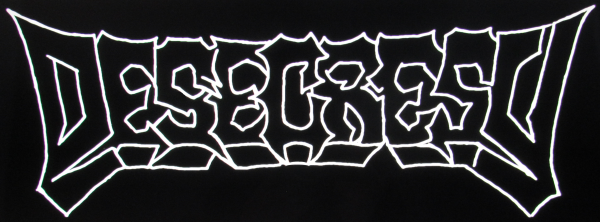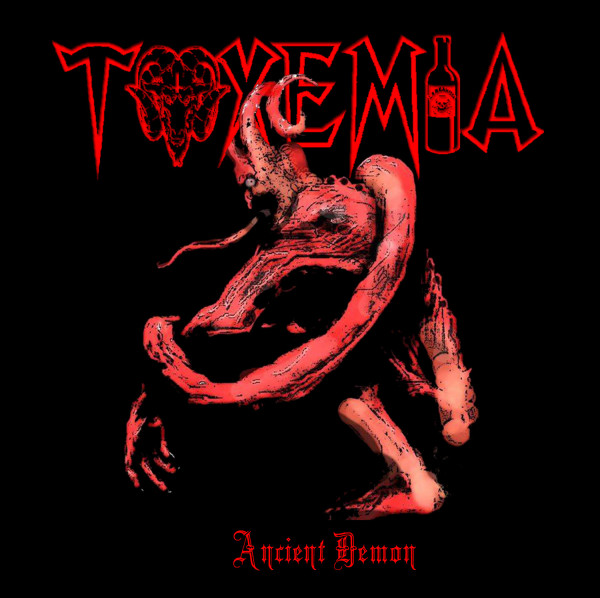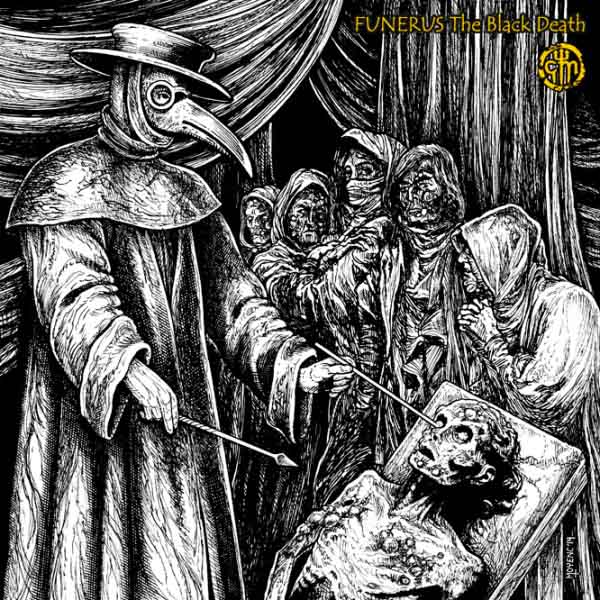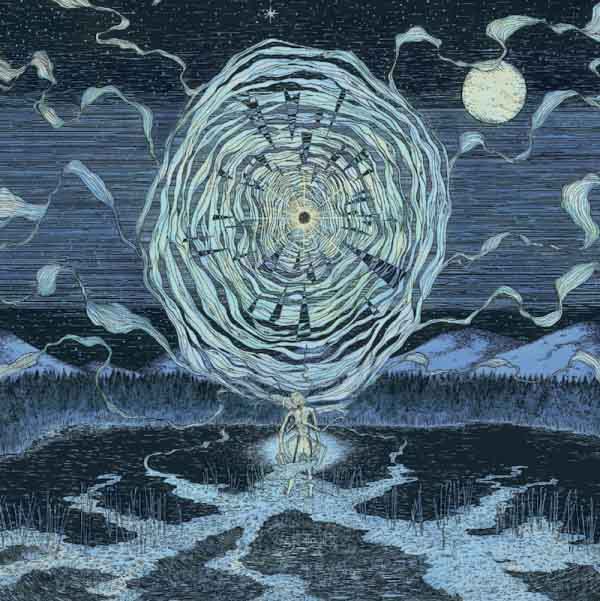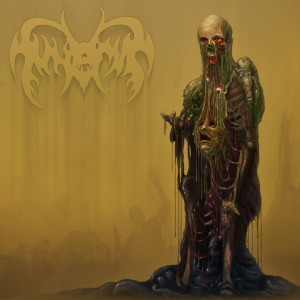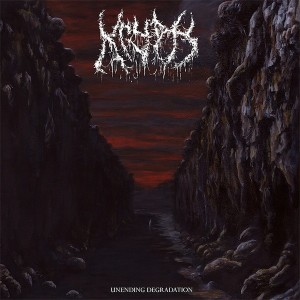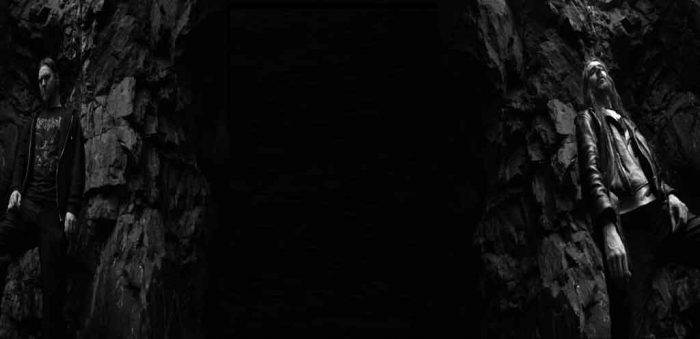
A few weeks ago, the opportunity to interview Finnish band Desecresy presented itself. Having been a long-time fan of their three solid albums of old school death metal with melodic and doom-death touches, I leaped at the opportunity. Little did I know that I would be fortunate enough to speak to both members of this dark and intense band, Tommy Gronqvist who plays all instruments, and Jarno Nurmi who commands vocals. Nor could I know that Desecresy fans have a lot to look forward to in the coming years. I expected intelligent and challenging answers, and neither I — nor you, Dear Reader — will be disappointed. Read on for my interrogation of these musical mood-crafters from the dark Finnish woods and caves…
Desecresy was born in 2009, but both of you played in other bands previously. Why the change to Desecresy, and what did you intend to do differently in Desecresy?
Tommi: Starting up Desecresy I wanted to concentrate more in the songwriting and creating instead of live playing. That is why there was never full line up gathered for Desecresy since there is no real need to have a separate guy for each instrument. From the beginning it was clear that Desecresy was more about the mood and therefor the song structures on the first album were less complicated compared to the Death Metal I had worked on before. Desecresy was never meant to be a tribute band or plain old school/retro band. Towards recent times, I have been happy to see that there are people who seem to get that.
Jarno: Yes, there definitely seems to be more understanding nowadays that we, among some others, are not merely an old-school death metal band. I think the beginning was quite fluent because there was no need to find more musicians, though it naturally took some time to get into the new thing after finishing others. Maybe there was also a certain kind of counter-reaction to the schedules and struggles of a band that plays live like we did earlier but it has proved to be more than just a reaction and we’ve had the chance to work effectively and release albums without problems with members joining and leaving.
What does the name “Desecresy” mean, or where is it from? (It might be a neologism of “desecreation” + “heresy”?)
Tommi: You could also throw secrecy in that neologism. Of course Desecresy is not a “real” word so its meaning is more in the feel of it than an actual description. I think of it as something that lies hidden not yet revealed.
Jarno: Yes and this idea of something hidden and unveiled has been one of the guidelines to me when considering the art of Desecresy and writing lyrics for example.
Your music is often described as doom-death, or slower death metal with doom metal influences. What doom metal bands influenced you? Were you inspired by nearby doom like Skepticism and Thergothon? What death metal influenced you? Did you have any other influences, including non-musical ones?
Tommi: The doomyness mainly comes from comparatively dropped tempo and the atmosphere, that is not so often searched by Death Metal bands. I haven’t listened much to the bands you mentioned. I do like some Doom/ Doom Death bands but to use them as reference of influence would be misleading. To mention some influential death metal bands I would say Abhorrence, Bolt Thrower, Demigod, Grave, Immolation, Incantation etc. I try not to be too much influenced by any particular band, so trying to make these lists always feels somewhat forced.
Non-musically the surrounding environment over all gives its own influence. I think changes of the seasons and changes of light in particular effects the music in the north. I don’t only mean natural environments either. For instance, colossal concrete or metal structures such as industrial buildings, bridges, water towers etc. have a surreal feel of space and solitude that can also transcend to music. “Infinite Halls” is one example of influence and inspiration from such surroundings.
Jarno: Surely playing death metal means we’re automatically influenced by at least some of the old bands, for example the ones Tommi mentioned but they are definitely only a part of the big picture. In the earlier years when playing in some other bands there was probably more will to sound like someone else or do something similar but not that much anymore. I have been a big fan of the Finnish death metal bands as well as the ones from the US and UK, for example Demigod, early Sentenced, Incantation, Immolation, Bolt Thrower and Benediction. Lot of black metal has influenced me, Burzum, Graveland, early Behemoth, Hate Forest, Ulver etc. I have to admit that I haven’t been following doom metal that much, only some early Candlemass and Solitude Aeturnus.
I find non-musical inspiration from mythology and history as well as nature. Some easily noticeable traces of these are visible in the lyrical concepts of Desecresy, refering especially to Greco-Roman and Northern mythology but these are usually handled through interpretative and renewing process. Some experiences of everyday life do influence song-writing but in such subtlety that the songs or lyrics don’t lose their feeling of otherness or remoteness. Literature inspires me a lot, such as Hermann Hesse, Knut Hamsun, Philip K. Dick, Aldous Huxley and many of the old masters of literature, poetry and philosophy.
Desecresy songs often make use of a single-picked rhythm lead melody over power chord rhythm guitar, which I compare to early Paradise Lost and the second part of Burzum “Key to the Gate” in a recent review. Were these influences? What prompted you to choose this musical direction? What do you like about it?
Tommi: I can’t really say those bands are influences to Desecresy, but similarities between bands don’t always come from direct absorption of influence. The similarities may be representative of where the bands are coming from musically and where they are going to. Even bands with different musical backgrounds may come to explore similar elements. Through Desecresy I want to search deeper to the dark and atmospheric feel without forgetting the core of Death Metal. This style works better for having memorable songs compared to some other forms of Death Metal (great in their own ways too) that concentrate on speed, technical maneuvering or just brutality.
Jarno: Early Paradise Lost and Burzum are both fine examples of highly inspiring and often atmospheric music that has depth in it and both have original feeling and mood in their releases. If we can speak of influences, attaining the atmosphere and depth with music is certainly something to seek and I believe in this sense some bands like Bolt Thrower and Demigod have also brought the realization that this kind of things can be done. I enjoy the certain seriousness there is in Desecresy and the strict concept of the art.
On Arches of Entropy, a death metal and Bolt Thrower-style grindcore sound can be heard. Why did you choose this style, and why did you migrate toward more Scandinavian death metal sounding material on The Doom Skeptron (more Abhorrence than Bolt Thrower)? (What inspired the title “Arches of Entropy”?)
Tommi: First of all, early Death Metal bands from Finland (which is not included in Scandinavia) such as Abhorrence, had different sound from the Swedish (Scandinavian) Death Metal! Sorry I’ll just step down from my soapbox here. I know what you mean by “Scandinavian.” Anyways… There was never an attempt to swing our style from one influence towards another. Merely to migrate towards our own sound. Every album is a counter reaction to the previous one, so some aspects are more present than others in each album. Probably that is why they may give different associations of bands to the listener. The title of the debut album refers to crypts containing the seeds of destructive forces.
Jarno: Arches of Entropy was the primitive beginning and I enjoy it as such. Raw and primitive, yet the mood and atmosphere is already there. The Doom Skeptron evolved a bit further and naturally Chasmic Transcendence was again a new step on this path. Interestingly the form of an arch has stayed visible in our album cover art for each of the first three albums and I’d like to think of this as a symbol of getting deeper in the original idea and bringing it into being. So the same “destructive force” has stayed there and has been looked at from different views without getting too much into one-sided naive and simple outlook at it.
As a two-person band, touring would be difficult. Do you have any plans to play live, and how would you pull it off?
Tommi: We haven’t been planning live sets, but I don’t want to restrain us by declaring that we would never do that. We would have to scratch up some kind of live session band to do it of course.
Jarno: As playing live is not among our priorities I think it would demand a very special occasion to ever do so. I don’t see it happening yet but who knows what the future might bring.
Much of your music seems to exhibit a contrast between death metal style interlocking riffing of an intensely structural nature, and atmospheric parts of a more relaxed and layered approach. What do these compositional techniques represent or what are they intended to do, and how does the contrast work in your songwriting?
Tommi: The use of those different approaches is there to create a mindset that is not aggressive or filled with pacified wonder, but somehow beyond those stages. That contrast is the biggest challenge in the music of Desecresy. Atmosphere is easily disturbed by structural changes in riffing and drum work, but Death Metal on the other hand often relies on the intensity of those changes. It is a guest to discover the philosopher’s stone to combine those elements to be simultaneously present in harmony.
On Chasmic Transcendence, there seem to be some influences from newer styles of metal, but adapted to the old school ways. What were these influences, and how did you put them into your own musical language so to preserve the old school feeling?
Tommi: Chasmic Transcendence is an album that could not have been recorded in the early 90s, and our goal was never just to repeat what was done back then, even though we are influenced by bands of that era. Again it is impossible to point some specific influences that would have been used to increase the modernity of the album. Everything I have ever heard influences what I come up with. What matters is how those influences are harnessed to create something new.
Jarno: It’s difficult to point out what influences the album holds in itself and I’m also a bit afraid of over-analyzing our work publicly. I feel it’s like a result of everything that was done to that point during the existence of Desecresy. It couldn’t have been done in the early 90s but it’s also an album that couldn’t have been done by any other band either.
Your songs are highly distinctive individually, but also seem to work together as an album of similar themes and related ideas. Do you “design” albums as a whole according to a plan or concept, or does this similarity come from other factors? What effect do you think it creates?
Tommi: The songs are first worked with separately but later, as there is more material and the lines of the album begin to form, there will be consideration of how much of which elements should be presented in each song. Certain similarity within the songs keeps the album whole. Jumping around too much between styles and states of mind only creates a tasteless mishmash.
Chasmic Transcendence was selected by DMU as one of the best of 2014. Your other albums belong on best of lists for their respective years as well. Are you getting the amount of fan attentiveness you hoped for? Is it difficult for original acts in metal at this point in time? Why?
Tommi: We have noticed that Chasmic Transcendence was included in your list and some other best of 2014 lists as well. It is gratifying to get that kind of recognition! I am so used to negative feedback that it has been a pleasant surprise to me. I think we are getting enough fan attentiveness. Things shouldn’t be too difficult for any band these days unless they are motivated by money or some rock stardom fantasy.
Jarno: I have been very happy to receive all the positive words and feedback from deathmetal.org and from people who contact us via email or facebook etc. It feels like we have received more attention after Chasmic Transcendence and of course it takes years of work to build up some reputation and we’re still relatively unknown. Yet I know we’re not really making it easier at all for people to find out about Desecresy as we don’t tour and don’t promote aggressively and to many we’re probably not the easiest music to listen to and get into. I think that healthy amount of elitism is needed and I am quite happy how things are slowly progressing.
Do you have plans to develop your musical style in different ways, such as longer songs, instrumental songs or more technical elements? Have you ever considered experimenting with longer melodies like Summoning?
Tommi: Maybe there will be longer more technical songs or maybe there will be shorter more primitive songs, or both. The songs form in the process. There can’t be that specific plan before hand of what will come. There may be longer melodies heard in the future but the repetition of a shorter melody is a deliberate choice in Desecresy songs.
Speaking of those leads I have a little bone to pick about that in depth analysis of Chasmic Transcendence on deathmetal.org. There was some complaint about the monotonous and simplistic use of lead guitars and how they are linked to the other parts of the songs. Desecresy‘s guitar leads are not meant to launch to some traditional ballad guitar solo wanking! They are meant to be minimalistic and nihilistic. Their purpose is not to be sentimental, but to set a certain stoic mental state.
Jarno: Some want us to be more aggressive and brutal, or more melodic or epic or faster or whatever but it would turn us into completely different band if we followed suggestions that people write in the internet. Yet experimenting on what works with Desecresy and what does not is certainly an on-going process but I’d say there is a certain artistic ideal for Desecresy and straying from that wouldn’t possibly bring good results. Anyway, as long as it’s reasonable and the purpose is clear I think there’s still a lot possibilities for songs that are for instance longer just like on the Chasmic Transcendence we had mostly shorter songs.
When you compose songs, what do you start with (a concept, an image, a riff, a melody, a structural idea)? When do the vocals and lyrics come in? How do you know when a song is “ready” for release?
Tommi: The composition of a Desecresy song can start with any of the things you mentioned. Lyrics and vocals come in at stage where other instruments are recorded and songs are other wise some what complete. There are sometimes changes made to the songs at the very last stage of the process. Eventually you just have to let go of the songs and the album and call it a day. That is surprisingly difficult mentally after a year or so of working on them.
Many claim the internet killed the death metal underground. Is this so, in your view? How is the underground doing? Does it still exist?
Tommi: In some ways the internet has killed the underground as it was defined in the pre-internet time, but that is not necessarily a bad thing. Sure you don’t need as much commitment anymore when anyone can find and listen to some obscure bands with just couple of clicks. On the other hand, since you don’t need to belong to a specific social circle to find those bands, more individuals have a possibility to find something great by their selves regardless of their connections. I also think that in the end, the underground metal is and always has been a bit vague term.
One could claim that something like Finnish Death Metal of the early 90s for instance could not have happened if there had been internet at the time, because there would have been too much world wide interaction restraining some initial characteristics to appear. I wouldn’t necessarily agree with that. I am sure however that without the internet, many of those bands would be unknown to most of the people that now are aware of them — including me.
Jarno: I don’t always know what people mean when they speak of the underground. I am not at all interested in every shitty band that there is trying to gain some underground reputation, yet I think most of the interesting bands that I listen to are part of the underground. In the past it was more difficult to find the right bands for yourself as you might not get much information from anywhere. Nowadays it’s probably equally difficult to find the bands because the internet is overflown with music and things to hear and it’s just too easy to become deaf and numb. The good side is that you can find interesting things by yourself without getting in touch with all the stupid people hanging around in the scene.
I think people easily accept bands that are not doing anything interesting after all and the internet gave every band almost equal possibilities to gain attention which is nowadays easily achieved if you have a funny or stupid idea of how to market your band to the audience. Some years ago some people could just call their new band religious or orthodox black metal and attain a mysterious image and the attention was guaranteed. Of course such deception will never last long but it always hinders the things that later on turn to be the most important things of a certain period. This is probably how it has always been and will be and somewhere beneath the hype and superficial facade the underground is doing just fine.
I know you both have day jobs and normal lives. What is your practice schedule like, and how does Desecresy fit into your lives? Are your families and friends (and jobs) accepting of what you do?
Tommi: I have not been condemned to hell by anyone I know this far.
I do kind of keep my band activities to myself because there isn’t much reason to share that with people who are not into it. As we don’t have a line up to play live, we don’t really practice together. I work on the instruments and record them. After that Jarno records his vocals.
Jarno: I think friends as well as other acquaintance have been quite supportive. I don’t speak much of my views or interests with my family or colleagues, though, and after all I’m not really interested if they support them or not. Schedule-wise it’s sometimes a bit complicated but I think we’ve had quite steady progress and not as much trouble as there could have been had there been a full line-up to rehearse with.
How do you achieve your distortion? What technique do you use to make your albums sound subterranean but clear and loud without being overpowering like some modern productions?
Tommi: Distortion mainly comes from Line6 über metal distortion pedal and the original Boss Heavy Metal II (Japan version). I don’t want to bore anyone with more details, nor do I want to give out the secrets of the trade, so to speak. I think there is a bit of home distillery side flavor in the Desecresy sound that much of the modern productions lack.
What’s next for Desecresy — are you writing material, thinking up ideas, and/or plotting world domination? If people want to know more about Desecresy, what should they do? Will you ever tour Texas and help us shoot guns, drink beer and wrestle alligators?
Tommi: Well that tour seems unlikely and from what I hear Texans don’t need help shooting guns or wrestling alligators! But as Finns we could extend a helping hand towards that beer. I know I like draining Budweiser down my throat! Or maybe there’s some more local Texas beers, I don’t know..
We have just finished our fourth album called Stoic Death, which will be out somewhere in the future, so keep an eye open for that! We are working on that world domination but meanwhile you can contact us in desecresy@hotmail.com or through desecresy@facebook.com.
I guess that’s all from me. Thank you for the interview! Appreciate your interest!
Jarno: Though we don’t tour or play gigs I do encourage someone to book us somewhere on the other side of the globe just to have some beers, I wouldn’t mind! Meanwhile I hope The Stoic Death will be out as soon as possible! Thank you for the interview and your great work with Death Metal Underground!
14 CommentsTags: death metal, desecresy, doom-death, Finland, Finnish Death Metal
